As the Byzantine Empire ruled Palestine, and Jerusalem largely turned into a Christian city, yet another new religion emerged in the Middle East in the 7th century CE. This third monotheistic Abrahamic faith would have a major impact on Palestine and the world in general. This episode covers a big, important and very complex historical period. It is impossible to do it justice in a few pages, but I aim not to lose the view of the forest for the trees.
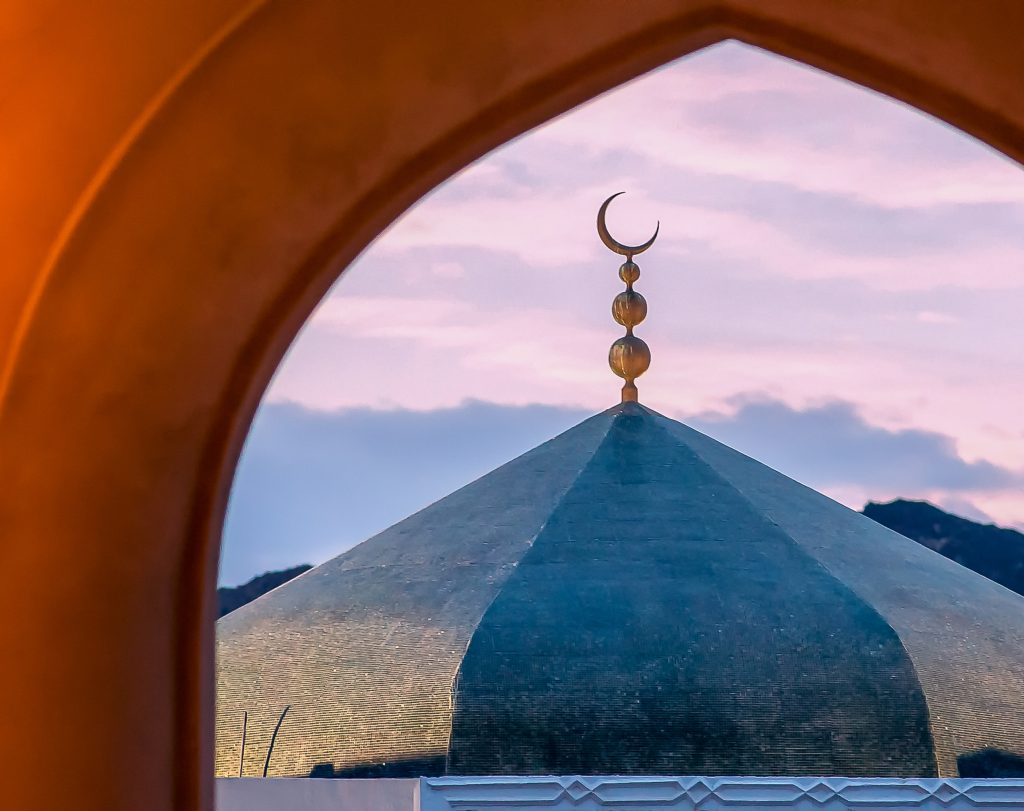
E5.1 A New Monotheistic Religion
E5.1.1 Historicity
- This series involves a critical historical review of Zionism and all the religions with an impact on Palestine. That naturally also means a critical look at the history of Islam
- Episode 2 had a critical look at the origins of Judaism
- Episode 4 had a critical look at the origins of Christianity
- This episode covers the origins of Islam, but will spend less time on a critical assessment of the archeological evidence, simply because there is so much less scientific archeological evidence to work with
- I will nevertheless start this episode with a few comments about the historical authenticity of the Islamic narrative, and critical historical and archaeological studies
- There are several obstacles to a critical assessment of the historical Islamic narrative:
- Obstacle 1: In general terms, Islamic Archaeology lagged behind archeology in the West and initially followed in the wake of colonialism and the expertise of colonial powers
- Colonial archaeologists often had a strong focus to find art and artifacts in the Middle East, which were in demand in museums and private collections in Europe. This did not serve the discipline well
- “A general lament at the unwillingness of Middle Eastern archaeology to adopt scientific methods has often been voiced during the twentieth century” [1]
- Political restrictions placed on archaeology activity in the Middle East, which is slowly starting to improve
- Obstacle 2: More specifically, a major obstacle is the fact that most of the relevant early historical Islamic sites are in present-day Saudi-Arabia.
- Although they allowed limited excavations in Saudi since the 1950s, there was a new Law of Antiquities, Museums and Urban Heritage, issued by a Royal Decree in 2014, and it sounds like they have a very active archeological program if one views Saudi sources (like this Saudi Website: [2]), this is only a small part of the picture
- “It is particularly frustrating that here has been no archaeological investigation of the Arabian environment traditionally associated with the life of the Prophet and the early development of Islam…. archeological investigation of sites in Saudi Arabia which might yield evidence for the nature of religion in the sixth and seventh centuries is actively discouraged” [3]
- Obstacle 3: A significant and insurmountable obstacle is the fact that “The Mosque of the Haram at Mecca and the Mosque of the Prophet at Medina have been razed to the ground and completely rebuilt in such a manner as to deny any possibility of archaeological excavation, even were it to be permitted” [3]”. These are two of the most important historical Islamic sites, completely lost to investigation
- Obstacle 4: A fundamentalist religion and scholars, resistant and actively hostile to critical investigation
- There are strong parallels to Christianity’s initial resistance and hostility to critical historical and archaeological investigation (including theologians and Biblical Archaeologists)
- Christians too:
- Regarded their “holy scripture” as accurate historical record and divinely inspired at that
- Had a strong vested interest to prove their religion as “true”, or at least shield it from damaging criticism
- Were quite biased as they initially practice archaeology, and largely forced their findings to fit their religious narrative
- It took Westen archaeology more than a century to largely (but not completely) break free from the shackles of the Biblical narrative (as covered in Episode 2). Middle Eastern or Islamic Archaeology still has a very long way to go to become critical and independent
- To conclude this little section on the obstacles with a quote from Stephen Humphreys “The first seventy years of Islamic history command our attention, therefore, not only because of the enormous interest of this period, but also because of the extraordinary methodological problems posed by our principal sources for it” [4]
- Obstacle 1: In general terms, Islamic Archaeology lagged behind archeology in the West and initially followed in the wake of colonialism and the expertise of colonial powers
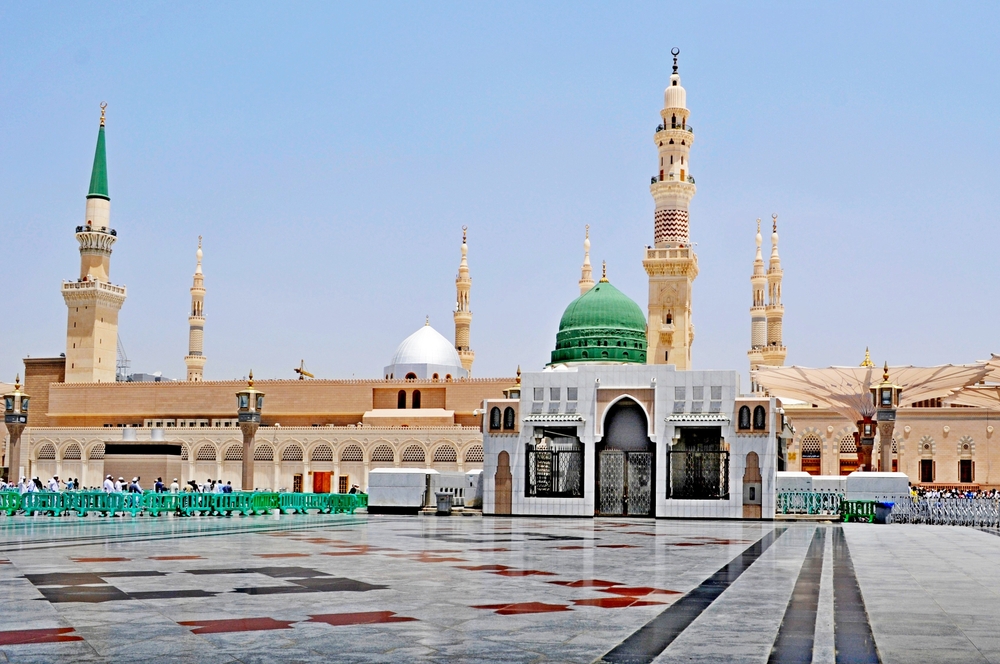
- Examples of some archaeological challenges which surfaced despite the obstacles:
- The most fundamental challenge is probably that the first archeological inscription referencing Mohammed and Islam is the Dome of the Rock in Jerusalem (which was either started or completed in 691/692, with this dating an example of another archaeological discussion) [5]
- By contrast, the earliest tombstone of a Muslim is from Egypt in 651. It (and other older sites) does not reference Mohammed or Islam
- So, the mystery here is why there is no archaeological record of Mohammed or Islam before the reign of Caliph al-Malik (of the Umayyad Caliphate, see below)
- Several archaeologists pointed out the fact that the historical narrative of Islam was almost exclusively based on Islamic manuscripts, and not on any archaeological findings or even non-Islamic manuscripts [5b]
- The Canadian historian, Dan Gibson (who dedicated his career to the study of the origins of Islam and the evidence for that) published his results in 2023 [5c]. His study led him to visit and compile the data on more than 200 early mosques and places of prayer in the Arabian Peninsula
- He points out that traditional accounts of the origins of Islam are solely based on Islamic manuscripts written 200 – 300 years after the events
- He also argues that the lack of archaeological evidence is problematic and that the little archaeological data available seems to be at odds with aspects of their origin story
- Stephen Shoemaker (a historian specialising in the early history of Christianity and Islam) is credited with publishing the first systematic historical-critical study of the Quran’s origins, including the radiocarbon dating of manuscripts (while there is an ocean of critical studies on the origins of the Bible). In this book [5d]:
- He concludes that the canonical written version of the Quran was most likely produced towards the late 8th century, a good 150 or more years after Mohammed’s death
- He shows that the forming of the Quranic canon had all the same issues and challenges the canonisation of the Bible experienced (the limitations of relying on oral traditions over long periods of time, human memory failures, different opinions influencing oral traditions, all resulting in a variety of oral traditions, and later religious claims about the process not necessarily being accurate)
- The most fundamental challenge is probably that the first archeological inscription referencing Mohammed and Islam is the Dome of the Rock in Jerusalem (which was either started or completed in 691/692, with this dating an example of another archaeological discussion) [5]
- Be that as it may
- I don’t think there is any reason to doubt the existence of Mohammed as a historical figure, much like the historical Jesus (despite many question marks and counter arguments), or the broad historical origin story of Islam
- Consequently, I will follow this broad historical tradition within Islam, but use critical academic sources where possible
- I don’t think variations to this historical tradition will have any significant impact on the overall historical picture emerging from this series on Palestine.
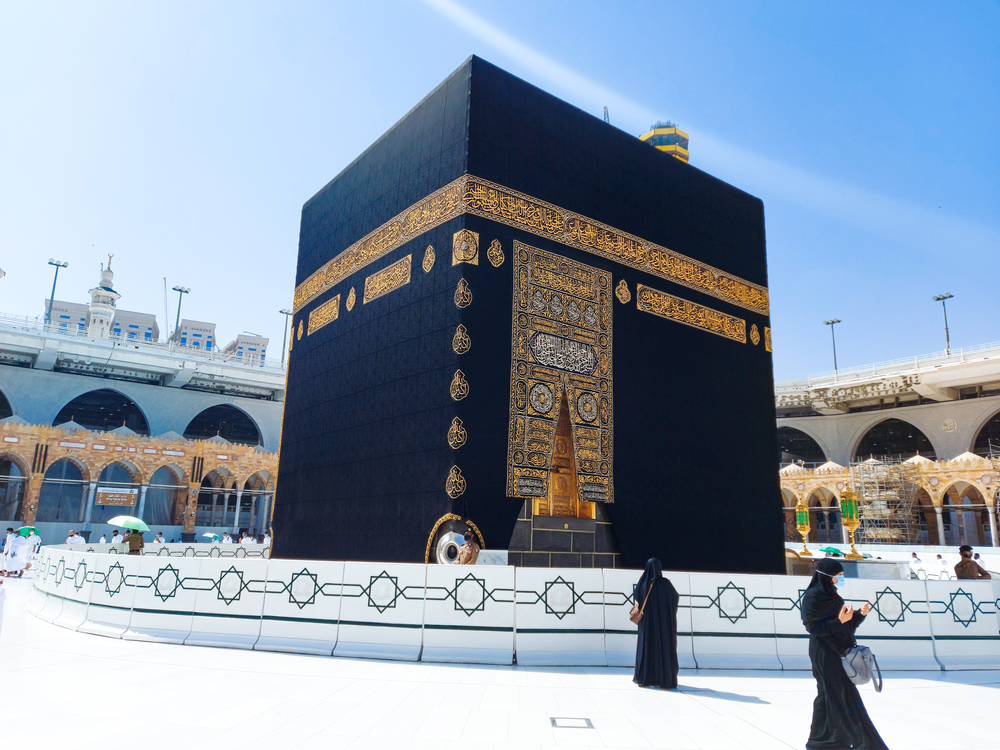
E5.1.2 The Founding of Islam
- General sources: [6] [7] [8] [9] [9b]
- Mohammed was born circa 570 CE in Mecca in present-day Saudi-Arabia to a prominent family (the Hashim clan) of the Quraysh tribe (not to be confused with the Jewish tribe in Medina, Banu Qurayza)
- The Quraysh was the ruling tribe of Mecca
- Mohammed’s grandfather led the Hashim clan and was one the tribal leaders of the Quraysh
- The Arab peninsula (including two prominent cities/towns, Mecca and Medina), was a polytheistic region, with a few Jewish tribes practicing their own monotheism
- In pre-Islamic Arabia, the Ka’aba (Kaaba/Kaba) shrine in Mecca housed 360 statues of tribal patron deities (much like the national deities found in Canaan during the Iron Age) [10] [11] [12]
- Three of these deities were the daughters of Allah (Allat, Manat and al-Uzza). As a quick aside: they are also mentioned in the Quran (Surah 53: 19-20), and with the following two verses (which were reportedly changed), became known as the “Satanic Verses” and the source of a major controversy within Islam [12b]
- It seems likely that Allah was the head of the polytheistic Arabian pantheon of gods in pre-Islamic times (much like Yahweh became the main god of the Israelite pantheon during the Iron Age, and later the “only god”). Extensive critical archaeological excavation of shrines in pre-Islamic Arabia would have been highly interesting and very useful, but that is unlikely to happen
- There was an annual pilgrimage to the Ka’aba
- Mohammed’s tribe, Banu Quraysh, were the guardians of this shrine and is reputed to have rebuilt it in 608 (just before Mohammed started his preaching)
- Mohammed’s father died before his birth and he was raised by his grandfather and then his uncle Abu Talib, who succeeded his grandfather as the head of the Hashim clan. As an orphan Mohammed’s only career prospect was that of a merchant, he accompanied his uncle on trade journeys to Syria, and he became a merchant for 25 years
- 610 CE is regarded as the origin of Islam in Mecca when Mohammed started to claim that he received visitations from the angel Gabriel in a cave, providing him with revelations from god (Allah in Arabic), at the age of 40
- Despite his prominent family the Meccans did not take kindly to his claims as the prophet of the only god or to his monotheistic message
- His early followers were:
- Family members and friends, like his wife, his young cousin Ali, his adopted son Zaid and his close friend Abu Bakr (who later also became his father-in-law)
- People who failed to attain the first rank in their tribes
- The weak and unprotected, like foreigners in Mecca
- The animosity against him continued to grow when he:
- Condemned polytheism and the Meccan forefathers who practiced it
- When his uncle died in 619, and the new clan head (a strong opponent of Muhammed) withdrew the clan’s protection for him
- The stories about the angel Gabriel developed further with the story of the Mi’raj in 620: Mohammed supposedly travelled to heaven and hell one night and personally spoke with earlier prophets, like Moses, Abraham and Jesus (who were all Muslims in his story)
- It is quite clear that Mohammed was familiar with the Tanakh, and the Layer 1 Narrative contained in it about the patriarchs
- He saw themselves as descendants of Abraham too (of his son Ishmael)
- The style, mythological world view and some content of the Quran (phrases and stories) are quite similar to the Old Testament. People not familiar with both these scriptures (i.e. most Christians) will probably not be able to distinguish between specific passages from them

- Mohammed fled to Medina circa 622 CE with his small following. This journey became the start of the Islamic calendar and became known as the Hijra or Hegira. He more successfully established himself there and managed to unite some of the Arabic tribes behind him by means of a determined, systematic and innovative military strategy
- Military historians who studied his history and success have high praise for him as military strategist, leader and general [13] [14] [15] [16] [17]
- “More than a great field general and tactician, he was also a military theorist, organizational reformer, strategic thinker, operational-level combat commander, political-military leader, heroic soldier, and revolutionary. The inventor of insurgency warfare and history’s first successful practitioner, Muhammad had no military training before he commanded an army in the field.” [16]
- Although he had no military training or experience:
- His experience with the logistics of arranging caravans in his days as merchant was quite useful
- He also appointed the best and most experienced warriors to leadership positions, not the most devout ones
- He started off with a small band of armed followers. He led an innovative insurgency for the time, in which they used ambushes and small guerrilla attacks on his adversaries. It is important to note that not accepting his status and message as a prophet was sufficient to be classified as his enemy
- With each successful raid or attack he captured the weapons, horses and camels of those he defeated, and in this way gradually grew his followers and military capabilities. His insurgent warfare tactics were innovative and highly successful
- He used the arms captured to arm his followers. Many of them were the poorest people from the Bedouin tribes. This vastly increased both their status and their loyalty
- He remunerated his poor followers better, by allocating more of the spoils of war to the soldiers than the custom of the time, with similar effects
- Initially he had to rely on Bedouin guides for his campaigns, until he developed quite a sophisticated intelligence network, which proved vital to his success
- Mohammed understood the value of propaganda and effectively used poets to sing his praises and denigrate his opponents in a largely illiterate society
- He used tactics to attack tribes and towns before they could form alliances, and cut off their economic lifelines, and communications
- In the decentralized culture of nomadic tribes he established a unified single military command, in his own person
- There are several records of training he put his soldiers through, although details of this have not been preserved
- He combined new recruits from different clans into military units, to develop new identities and loyalties
- He effectively used violence and intimidation, including the assassination of rival leaders, and the public execution of those he regarded as his enemies (like the massacre of Banu Qurayza covered below, or public beheadings in other cases)
- Although there are some disagreements on the numbers, it is clear that Mohammed was responsible for 80 – 100 military expeditions in his lifetime. He personally participated in 28 of these, which included 8 major battles
- Several of these expeditions were launched from Medina against his own tribe (and family) in Mecca, Banu Quraysh. The first big battle against them was the Battle of Badr on 13 March 624 CE near the city of Badr in present-day Saudi-Arabia [18]
- Mohammed’s Muslim forces was victorious and managed to kill several Qurayshi leaders
- The Islamic narrative attributed this to the divine intervention of Allah, as one would expect. There are also explicit stories about angels participating in this battle and assisting Mohammed’s forces
- This was the start a 6-year war against his own tribe.

Surah 33.26-27 (33.26) “Allah brought down from their fortresses those People of the Book who had supported the invading confederates and cast such terror into their hearts that some of them you kill and some of them you take captive. (33.27) Allah made you inherit their land, their dwellings, and their goods, and a piece of land on which you had not yet trodden. Verily Allah has power over all things.”
- Jewish tribes in Medina
- There were three Jewish tribes in Medina when Mohammed arrived there, Banu Qaynuqa, Banu Nadir, and Banu Qurayza. Due to their own monotheistic religion, they were not receptive to Mohammed’s claims to be the Prophet of Allah
- Mohammed expelled two of them circa 624 and 625, in two of his military expeditions. They then migrated to Syria where they joined a Jewish community
- The third, and biggest, Jewish tribe (Banu Qurayza) was massacred circa 627 [19]
- They were not supporters and were accused by Mohammed of aiding his enemies from Mecca
- Mohammed and his forces successfully laid siege to their fortress
- Banu Qurayza then negotiated to surrender and be expelled with their personal belongings
- Mohammed refused this, took them to Medina were all the men were massacred in cold blood, most women and children sold into slavery, and some women were handed out to Muslim leaders
- Although some Muslim apologetics recognize the brutality of this massacre, they tend to justify it based on the “treason” committed by the Jews and that it was necessary to establish Islam
- This is recorded in some Hadith, but also in the Quran (e.g. Surah 33)
- Surah 33.26-27 (33.26) “Allah brought down from their fortresses those People of the Book who had supported the invading confederates and cast such terror into their hearts that some of them you kill and some of them you take captive. (33.27) Allah made you inherit their land, their dwellings, and their goods, and a piece of land on which you had not yet trodden. Verily Allah has power over all things.” Commentary by the Islamic Foundation of the UK indicates that verse 26 and 27 refer to Banu Qurayza and their annihilation after the Battle of Trench [20]
- We see a new Islamic narrative emerging here in the Quran: that Allah not only gave them victory in this massacre, but more importantly personally gave them the land, dwellings and possessions of their Jewish enemies. This is very similar to the Layer 1 Zionist Narrative as captured in the Tanakh and the Bible (Yahweh assisting the Israelites to victory in the genocide of several Canaanite nations, and also giving them the lands of these nations)
- Apart from his effective military campaigns, several other factors assisted Mohammed in uniting the tribes of Medina
- Geography. “Muhammad chose Medina as his base of operations because of its strategic location. Medina was close to the main caravan route from Mecca to Syria that constituted the economic lifeline of Mecca and other oases and towns dependent upon the caravan trade for their economic survival. Medina was also sufficiently distant from Mecca to permit Muhammad a relatively free hand in his efforts to convert the Bedouin clans living along the caravan route” [16]
- The conversion of the most influential tribal leader
- The Treaty of Medina, which Mohammed created (and which established his authority)
- It dealt with the rights and responsibilities of the different tribes in concrete terms, and in this regard, it used the existing tribal codes
- It also dealt with the rights of “non-believers”, giving the dhimmi status (some level of protection and freedom of religion, which was more tolerant than Christianity at the time). The Treaty only mentions protection in a general sense in Clause 15, without providing any details
- It explicitly forbade providing any assistance to Banu Quraysh, in Clause 43
- It’s not a big document, and can be read here in its entirety [21]

E5.1.3 The Conquest of Mecca
- After 8 years Mohammed succeeded in growing his following and his army to such an extent that he attacked Mecca (and his own tribe with which he has been engaged in running battles for the previous 6 years) [16] [22]
- Indications are that he could then muster a force of more than 10,000 men (a more conventional force with integrated infantry and cavalry), and that he conquered Mecca without much resistance and with few casualties
- He issued an amnesty for people’s “offences” in the long struggle against him, except a few key leaders who were executed
- Mohammed purged the Ka’aba from statues and prohibited any further polytheism. It became the primary Islamic shrine and the destination of the annual pilgrimage [22b]
- Most Meccans then converted to Islam and started following their new prophet. This included the Quraysh tribe, who became quite influential in early Islam and part of an ongoing rivalry within Islam
- With the conquest of Mecca, Mohammed established Islam after militarily vanquishing his two main opponents:
- The influential tribes of Mecca, especially the Quraysh
- The Jewish tribes refusing to follow him
- His two main achievements, which facilitated the expansion of Islam
- Establishing a strong military power, which used innovative tactics
- He proved himself an excellent military strategist and the military machine he left behind was critical for future battles (both internal and for expansion)
- In this process he revolutionized Arab warfare and personally picked and trained his generals, who proved highly effective after his death
- A single story (“There is no god except Allah, and Mohammed is the Messenger of Allah”), which could unify the many nomadic (and warring) tribes of Arabia for the first time
- Establishing a strong military power, which used innovative tactics
- These two achievements went hand-in-hand, as he also motivated the soldiers with the story that they were doing the work of Allah. Mohammed was the consummate warrior-prophet
- In all our previous episodes we saw armies fighting in the name of some god or another (the Canaanites, the ancient Israelites, the Assyrians, the Persians, the Romans and the Christians), so this was not a unique development by any means. However, Mohammed took this to the next level, by placing religion at the centre of military activity and painting soldiers as the primary instruments doing Allah’s work
- Life was less important than dying for Allah, with martyr status for the soldier and honour for his family. Several hadith mention that Mohammed promised 72 “houris” to male martyrs. This is mostly translated as “virgins”. However [23]
- The Quran mentions “houris” as celestial beings, but this specific promise does not appear in the Quran itself
- There are disagreements about the meaning and translation of the term. One alternative meaning is “women with big, beautiful eyes”
- This entire story proved very powerful (and enduring), leading to far more motivated soldiers with a clear strategic purpose.
E5.1.4 Mohammed’s Death
- As Mohammed continued wider military campaigns to expand Islam, he issued more specific instructions to his generals about the status of the people they conquered:
- “People of the Book” (the other Abrahamic monotheists), received some legal protection and the right to practice their own religion
- All non-Muslims had to pay the jizyah tax
- This became standard practice under the rule of the Muslim Caliphate
- Mohammed’s attacks on the Byzantine Empire
- After Mohammed conquered Mecca, he turned his attention to the Byzantine Empire, to his north and west
- This included the Battle of Mu’tah and the Tabuk expedition
- Mohammed died on 8 June 632 after a short illness, before he could conquer parts of the Byzantine Empire
- Although there are some disagreements about Mohammed’s marriages, the majority view seems to be that he had 11 wives and left 9 widows [24]
- With Mohammed’s death his successor (Abu Bakr) became the first Caliph, the political leader of the new Muslim Caliphate (see E5.2.1 below).
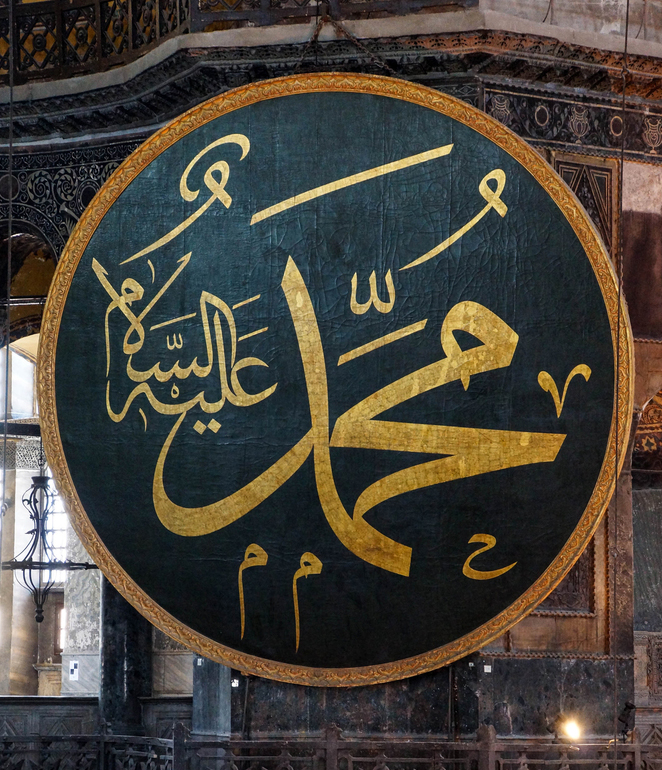
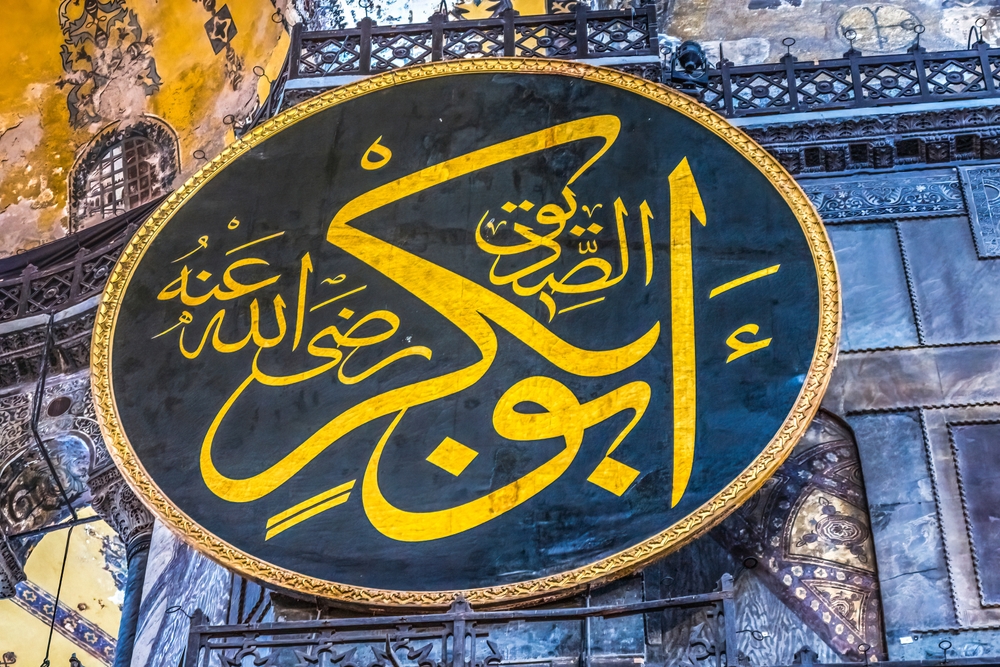
Left: The Prophet Mohammed Medallion in the Hagia Sophia, Istanbul [Image credit: Shutterstock]
E5.2 The Muslim Caliphate and the rapid Expansion of Islam
Palestine was part of, and ruled by, the Muslim Caliphate since 638 until 1917 (for almost 1300 years). This is a long and complex history, so I just capture a very brief summary while attempting not to leave gaps [25] [25b] [26] [27]. This does not mean that these historical periods and their respective rule was as clear-cut as it is shown here, in retrospect. It was much messier and more unclear at the time, and there were also periods when other Muslim forces invaded and ruled the Levant. The Abbasid Caliphate was an especially tumultuous period, despite the fact that it was regarded as a Golden Period.
E5.2.1 The Rashidun Caliphate (632-661 CE)
- This is the original Caliphate under the 1st 4 Caliphs who were all part of Muhammed’s inner circle and 3 were related to him. Literal meaning “the Rightly Guided Caliphs” [29b]. These first 4 Caliphs were:
- Abu Bakr (632 – 634). He was Mohammed’s close friend (and his father-in-law), who became the first Caliph after Mohammed’s death. By Mohammed’s death he ruled over the tribes of Mecca and Medina. Abu Bakr united all the tribes of Arabia after the Ridda Wars
- There is a tradition in Islam that Mohammed appointed scribes who wrote down all the revelations he received, as he was illiterate. There is also a story that the angel Gabriel taught him to read
- However, according to another Sunni tradition, Abu Bhakr gave instructions to scribes to write down the oral tradition about Mohammed after his death, as remembered and told by those who knew him well. This became the origin of the Quran and the Hadith. According to this tradition Aisha (the youngest widow of Mohammed) narrated more than 2,000 hadiths for these scribes [27b]
- Umar (634 – 644). He was a companion and a father-in-law of Mohammed. He was murdered in 644
- Uthman (644 – 656). He was a companion and son-in-law of Mohammed who became Caliph at 70 and was assassinated at 82. When he became Caliph there were 4 different versions of the Quran in circulation (in Damascus, Basra, Hims and Kufa). He decreed one of these 4 (possessed by one of Mohammed’s widows) as the authentic Quran. The subsequent controversy was one of several factors leading to Uthman’s assassination
- Ali (656 – 661). He was Mohammed’s cousin and another son-in-law. He moved his capital to Kufa (in present-day Iraq). Kufa became a stronghold of Ali supporters and opposition to the Umayyad Caliphate (see E5.2.2 below). According to Shia tradition:
- One of the oldest mosques is the Grand Mosque of Kufa, claimed to be built in 636
- Caliph Ali was assassinated in 661, while he was praying in this mosque
- Abu Bakr (632 – 634). He was Mohammed’s close friend (and his father-in-law), who became the first Caliph after Mohammed’s death. By Mohammed’s death he ruled over the tribes of Mecca and Medina. Abu Bakr united all the tribes of Arabia after the Ridda Wars

- Internal Violence
- The 1st Caliph (Abu Bakr) immediately had to fight the Ridda Wars (September 632 to June 633) to stamp out a rebellion by some of the Arab tribes, which also involved claims of rival prophets [28] [29]
- Three of these first 4 Rashidun Caliphs were assassinated by other Muslims. There was also an assassination attempt on the 5th Caliph (Hasan, Ali’s son and successor)
- There were 2 Fitnas (Civil Wars) for control of the Caliphate within the 1st 60 years of its existence. The 1st Fitna overthrew the Rashidun Caliphate with military force, and there was a parallel Caliphate for 8 years during the 2nd Fitna (see E5.2.2 for more detail) which was required a war to resolve
- There was large-scale expansion of Islam under Caliph Umar (of the original Rashidun Caliphate) [25]
- He conquered Syria in 634, where the Jews welcomed the new Arab conquerors
- In 638 Jerusalem was conquered from the Byzantine Empire, with the rest of Palestine falling by 640/641
- The Arab forces then moved on to Egypt, with Alexandria falling in 642
- From there the Arab forces pushed north into the Persian and the Byzantine Empires
- There are different opinions about the date Shia Islam originated
- Some reckon it goes back to 632, as there was an immediate disagreement between Mohammed’s followers about his successor, with the ones who became known as Shias later on in support of Ali, who eventually became the 4th Caliph (and the final Rashidun Caliph)
- Others put this date at 661 with the assassination of Ali and the end of the Rashidun Caliphate, when Ali’s followers, including many non-Arab Muslims, rejected the authority of the new Umayyad Caliphate
- Shia Islam has an Imam instead of a Caliph, with a stronger spiritual role than a Caliph. Ali is regarded as the first Shia Imam
- Qom in present-day Iran is widely regarded as the religious centre of Shia Islam, the equivalent of Mecca in Sunni Islam
- The entire Rashidun Caliphate is largely (and retrospectively) regarded as Sunni today, including Ali’s reign
- The Rashidun Caliphate ruled Palestine from 638 to 661 when Ali was assassinated. The Umayyad Caliphate then gained control
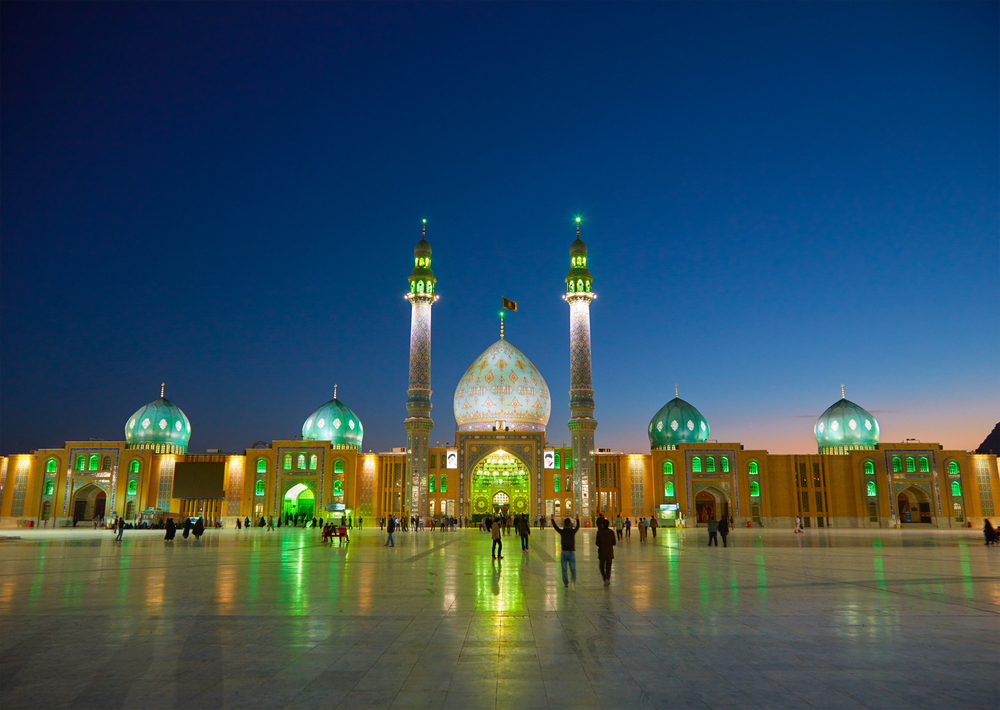
E5.2.2 The Umayyad Caliphate (661 – 750 CE)
- General sources: [26] [27] [30]
- The First Fitna [31]
- The start of the 1st Fitna can be placed at the revolt against Uthman and his assassination by supporters of Ali, which led to him becoming the 4th Caliph in 656
- The opponents of Ali continued a series of battles against him, to end his reign as Caliph and to avenge Uthman’s death
- Mohammed’s youngest widows (Aisha, the daughter of Abu Bakr) was one of the leaders of this civil war against Ali
- In 661 they assassinated Ali, and when his son, Hasan, succeeded him, they attacked him and had an unsuccessful assassination attempt on his life. Hasan is regarded as the second Shia Imam
- Their military revolt forced Hasan to sign a treaty with them
- He abdicated as Caliph
- It established the Umayyad Caliphate, based in Damascus with Mu’awiyah I as Caliph, a cousin of the 3rd Caliph (Uthman)
- This was a Sunni Caliphate
- This treaty ended the Rashidun Caliphate and the First Fitna
- The Second Fitna [32]
- With the death of Mu’awiyah I in 680 the revolt and rivalry erupted again in the Caliphate. It involved two big uprisings against the Umayyads
- One was launched from Kufa by Husayn (the son of the 4th Caliph Ali, and grandson of Mohammed). This was quickly suppressed and Husayn killed in Oct 680. He is regarded as the 3rd Imam of the Shia
- The second was by al-Zubayr (the grandson of Abu Bakr, and a member of the Quraysh tribe in Mecca)
- He established a parallel Caliphate in Mecca from 683 to 692, with himself as Caliph
- He made major changes to the Ka’aba
- After 5 years of turmoil in the Umayyad Caliphate, al-Malik became Caliph, restored order and became quite a consequential Caliph. He conquered the parallel Caliphate in Mecca, with al-Zubayr killed in battle in 692
- The 2nd Fitna was suppressed after 12 years, 60 years after Mohammed’s death
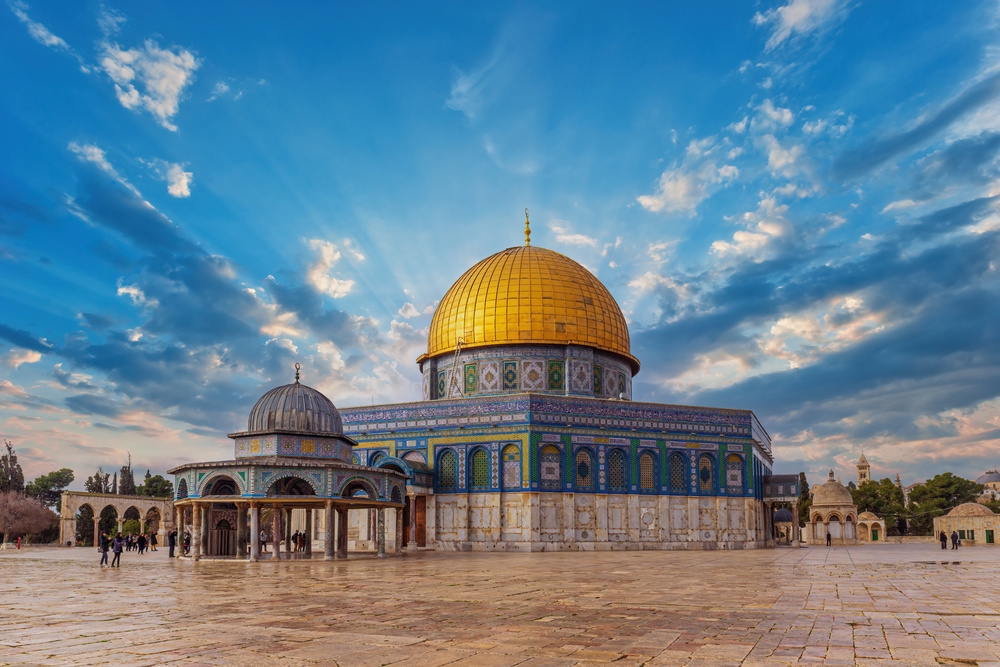
- In Palestine
- They renamed “Palaestina” to the “Jund Filastin” province
- The Umayyad Caliphate embarked on large-scale building projects
- al-Malik built the Dome of the Rock in Old Jerusalem towards the end of the 2nd Fitna
- And the Al-Aqsa Mosque was built shortly after, by either al-Malik or his successor (al-Walid I). It was built right next to the Dome of the Rock, and next to the Western Wall of the 2nd Temple and the Church of the Holy Sepulcher built by Constantine (see Episode 4)
- The dating of this construction is not as clear-cut as Islamic tradition holds (see E5.1.1 above)
- The Umayyad Caliphate expanded into Europe, after they won the 2nd Fitna and consolidated their power
- In 711 they started their invasion of the Iberian Peninsula (present-day Spain)
- And 719 was the start of their invasion of Gaul (present-day France)
- The Umayyads were overthrown by another dynasty from Mecca (the Abbasids) around 750 CE, but they still continued to rule in Europe
- The Caliphate successfully expanded at quite fast pace, despite internal rivalry, turmoil and warfare. The reasons for this are varied:
- Mohammed left a big and well-trained army behind, which fundamentally change the warfare of the Arab tribes. “Had Muhammad not introduced this new way of thinking to Arab warfare, the use of later Arab armies to forge a world empire would not only have been impossible, it would have been unthinkable” [16]
- This army was motivated by religious zeal
- The Byzantine and Persian Empires were weakened by long wars between them
- The Seljuk Sultanate, on the Byzantines’ doorstep, also attacked them and conquered parts of their empire
- The Byzantine Empire experienced a plague
- Christian Arabs joined forces with the Caliphate and Jews also welcomed the new Arab conquerors
- By conquering Egypt first the Caliphate cut off important food supply to the Byzantines and also improved their own food supply and revenue
- There was no shortage of mythological stories to explain these developments
- The Muslims saw the power and favour of Allah (and other celestial beings) in their military successes
- The Byzantines saw the punishment of the Christian god in their defeats

E5.2.3 The Abbasid Caliphate (750 – 1258 CE)
- This Caliphate is regarded as the Golden Age of Islam [26] [27] [33] [34]
- They moved the capital of the Caliphate from Damascus to Baghdad in 762. At the height of their power in the middle of the 9th century they controlled a vast territory, including all of the Middle East
- But it was also their Golden Age due to the intellectual progress they made. They benefitted from the knowledge of the Byzantine and Persian Empires they conquered, but then built on this: “Science, technology, and other fields of knowledge developed rapidly during the golden age of Islam from the eighth to the 13th century and beyond. Early Abbasid caliphs embarked on major campaigns seeking scientific and philosophical works from eastern and western worlds. Baghdad, the capital of the Abbasid Empire, became the center of intellectual and scientific activity.” [34]
- They had military support from the Persians and the number and influence of non-Arab Muslims increased
- Their political power then continued to decline
- The Fatimids conquered large part of their territory and so did the Seljuk Sultanate
- They later only controlled Baghdad and its immediate surroundings
- They were politically taken over by the Shiite Buyids from present-day Iran in 945 CE
- The Seljuks ousted the Buyids from Baghdad in 1056 CE
- However, the Abbasids retained their Caliphate status despite their lack of military and political power. Their big political influence lied in deciding the Islamic legitimacy of Islamic Sultanates
- They were destroyed by the Mongols in 1258, which was also the destruction of the Sunni Caliphate
- Although this Caliphate lasted until 1258, they did not rule Palestine for most of this time (see below)
E5.2.4 The Mamluk Caliphate (1261 – 1517 CE)
- The Ayyubid Dynasty created a warrior-slave class (mamluks), which became common in the Muslim Empires of the time [36] [36b]
- When the Ayyubid Sultan died in 1250 the Mamluk Generals killed his heir, took over the Sultanate and created their own Mamluk Dynasty from within. So, the Mamluk Sultanate/Dynasty started in 1250, but not the Mamluk Caliphate
- After the destruction of the Abbasid Empire and Caliphate by the Mongols in 1258, the Mamluks reinstated a Caliph in Cairo in 1261 to help consolidate their position in the Muslim world
- They only became the Mamluk Caliphate in 1261
- There was a period of 3 years without a Caliph (1258 – 1261)
- The Mamluks played a significant role in the history of Islam by vanquishing the invading Mongols who destroyed the Abbasid Caliphate, and also by delivering the final victory over the Christian Crusaders
- They ruled Palestine from 1250 to 1517, although the Khwarazmian Empire controlled Jerusalem for a a short while (see E5.3.4 below)
E5.2.5 The Ottoman Caliphate (1517 – 1924)
- General sources: [37]
- The Ottoman Empire and the Ottoman Caliphate did not fully coincide and have to be distinguished
- The Ottoman Empire was founded in 1299 by Osman I, a Turk from one of the Seljuk tribes [37b]
- It only became the Caliphate in 1517 when it conquered the Mamluk Caliphate
- The Ottoman Empire fell in 1918 during WWI, but the Empire only officially came to an end in 1922, and the Ottoman Caliphate was only officially abolished in 1924. This was the end of the Muslim Caliphate
- I only include the basic dates here for completeness’ sake, in this big picture section about the Muslim Caliphate. See E5.5 below for details about the Ottoman Empire and its rule of Palestine.
E5.3 Muslim Sultanates and Wars during the Abbasid Caliphate
During the Abbasid Caliphate (based in Bagdad), Palestine was ruled by 5 different Muslim forces who all made war on one another (the Abbasids, the Seljuks, the Fatimids, the Ayyubids and the Khwarazmians), all before the Mamluks took over in 1250 and with the Mongols having some successful raids into Palestine. This involved and messy period can be confusing to follow, which is why I’m adding some additional information. Christian Crusaders also ruled Jerusalem for a while in between, which is covered in the next section (5.4).
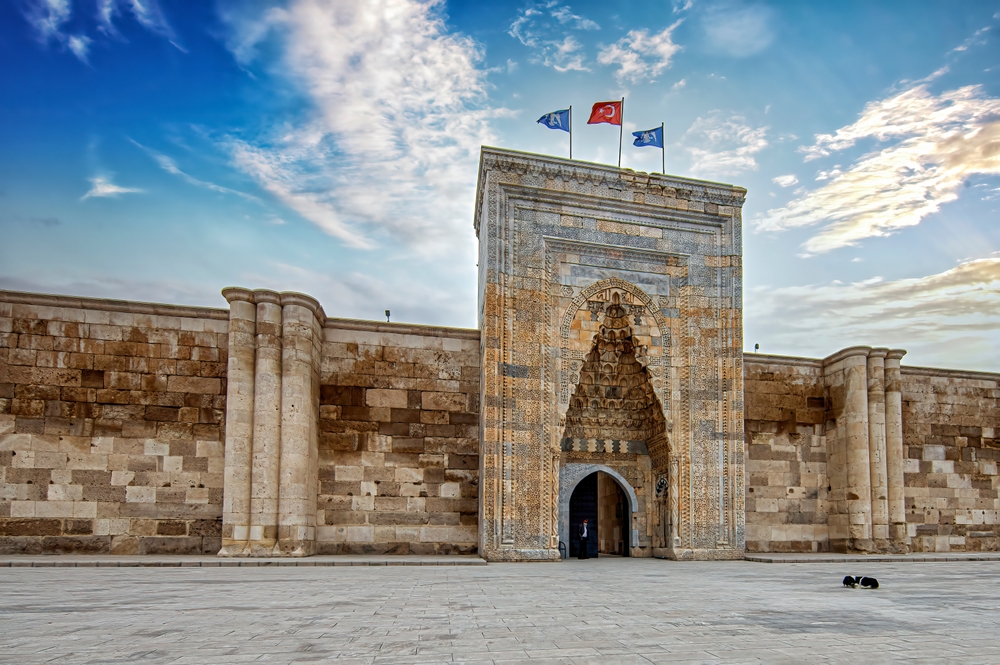
E5.3.1 The Seljuk Empire
- The Seljuks (a Muslim Empire from present-day Turkey, preceding the Ottoman Empire), had an especially brutal reign in the 11th century and controlled vast territories, but never became the Muslim Caliphate [38]
- The Seljuks were partially Persianized and came into contact with Islam on the banks of Syr Darya (roughly in present-day Kazakhstan), towards the end of the 10th century. They converted to Islam and played a crucial role in the expansion and future of Islam
- They conquered parts of the Byzantine Empire, conquered Jerusalem from the Abbasids, lost it to the Fatimid Dynasty and waged war against the Crusaders
- Although the Seljuks later ruled over most of the Abbasid territories, they allowed the Caliphate to retain its spiritual authority
- One of the Seljuk tribes later became the founders of the Ottoman Empire, so in a way the Seljuk Empire morphed into the Ottoman Empire
E5.3.2 The Fatimid Dynasty
- A dynasty based in North Africa who created their own Shia Caliphate in 909 based on the claims to be the descendants of Mohammed’s daughter Fatima. They took over Palestine from the Seljuks and then lost it to the 1st Crusade in 1099 [39]
E5.3.3 The Ayyubid Sultanate
- Another Sunni Sultanate from present-day Egypt, which was quite powerful in the 12th century [40]
- Founded by Saladin in 1171 when he deposed the last Fatimid Caliph
- They fought several battles against the Crusaders, took Jerusalem from the Crusaders in 1187 and ruled Palestine for 42 years
E5.3.4 The Khwarazmian Empire
- A Turkish-Persian Sunni Muslim Empire and a dominant force in the 13th century. They were from central Asia and responsible for the final conquest of Jerusalem from the Crusaders in 1244 CE [41]
E5.3.5 The Mongols
- They invaded the Middle East from further east, crushed the Abbasid Caliphate and the Khwarazmian Empire and even had a few raids into Palestine.
E5.4 The Crusades (also during the Abbasid Caliphate)
There was a total of 8 official Crusades and many unofficial ones (1095 – 1270 CE). These were military campaigns organised by different popes and Western leaders to take Jerusalem and the “Holy Land” from Muslim rulers. [42] [43] [44] [45] [46] [46b]
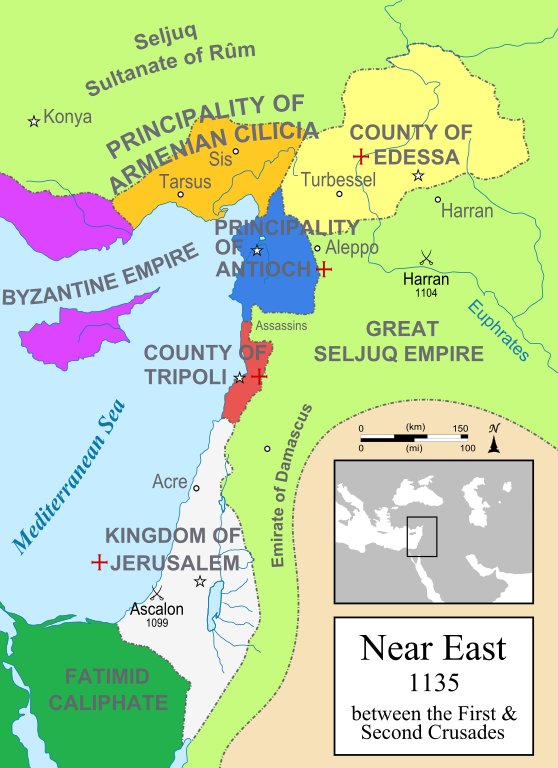
E5.4.1 The 1st Crusade (1095 – 1102 CE)
- [47]
- The 1st Crusade was arranged by Pope Urban II in response to a request for help from the Byzantine Emperor, Alexios I, against the expanding Seljuk Empire and to “free the Holy Land”
- It was the most successful Crusade, which succeeded in conquering Jerusalem from the Fatimids in 1099, despite all their logistical challenges
- To retain their new territories Knights Templars were created, taxes were instituted, and 4 western settlements (or Crusader States) were established
- The Kingdom of Jerusalem (established in 10
- 99)
- The Principality of Antioch (established in 1098)
- The County of Tripoli (the last one to be established in 1102)
- The County of Edessa (established in 1098)

- The “Franks”. The Crusader armies were made up from many Western powers, but the majority were initially from France, and consequently the Crusaders became known as “The Franks”
- Despite the initial success of the 1st Crusade, they were unable to repeat this for several reasons
- In-fighting, disagreement and general disorganization
- Lack of strategic planning
- Significant logistical challenges
- Strong Muslim Empires in the region
- The Crusades were one of the most infamous periods in the violent history of Christianity
- Western and Arab historians alike describe the rape and pillaging of the 1st Crusade, as well as the mass slaughter of Muslims and Jews during the battle for Jerusalem. This included several anti-Jewish actions and Jewish massacres in the Rhineland of France on their way to the “Holy Land”
- Establishing the Crusaders states also initially led to the massacre and rape of local populations before they realized they needed cooperation from the diverse local population to succeed
- The violence and pillaging of the Crusaders as they passed through Europe and through his Empire, caused a big rift between them and the Byzantine Emperor, which even led to battles between the Christian Crusaders and the Christian Byzantine Empire and to the ransacking of Constantinople as well
E5.4.2 The 2nd Crusade (1147 – 1149 CE)
- [48]
- It was the first Crusade which was led by Western Kings: Conrad III (the German King) and Louis VII (the King of France)
- It was a complete failure with disagreements about military targets
E5.4.3 The Fall of Jerusalem to Saladin of the Ayyubid Sultanate in 1187 CE
- Jerusalem was under Christian rule as part of the new Kingdom of Jerusalem for 88 years
E5.4.4 The 3rd Crusade (1189 – 1192 CE)
- [49]
- Launched by Pope Gregory VIII to retake Jerusalem
- Led by 3 Western kings: Frederik I Barbarossa (King of Germany and the Holy Roman Emperor), Philip II (King of France), and Richard I “The Lionheart” (King of England)
- They failed and did not even reach Jerusalem, but captured Acre and turned it into the capital of the Kingdom of Jerusalem
E5.4.5 The 4th Crusade (1202 – 1204 CE)
- [50]
- Not led by any king, but 2nd tier nobles, mostly from France
- Another failed Crusade, in which they attacked and plundered Constantinople, the capital of the Christian Byzantian Empire
E5.4.6 The 5th Crusade (1217 – 1221 CE)
- [51]
- Frederik II (the Holy Roman Emperor) was going to lead this Crusade, but did not go ahead with his plans due to political turmoil at home
- Another failed Crusade plagued by lack of leadership and strategy
E5.4.7 The 6th Crusade (1228 – 1229 CE)
- [52]
- Holy Roman Emperor Frederik II personally led this Crusade, after not joining the 5th Crusade
- In 1229 he negotiated and signed a treaty with Sultan al-Kamil of the Ayyubid Sultanate to allow Christian rule in Jerusalem. This was aided by his ability to speak Arabic, and the domestic power struggle the Sultan faced at the time
- This diplomatic endeavour achieved what the previous 3 Crusades were unable to achieve militarily and Frederik consequently crowned himself King of the Kingdom of Jerusalem in the Church of the Holy Sepulcher
E5.4.8 The Final Fall of Jerusalem in 1244 CE
- Jerusalem fell to the nomadic Khwarazmians, allies of the Ayyubid Sultanate
- This time Jerusalem was only in Christian hands for 15 years

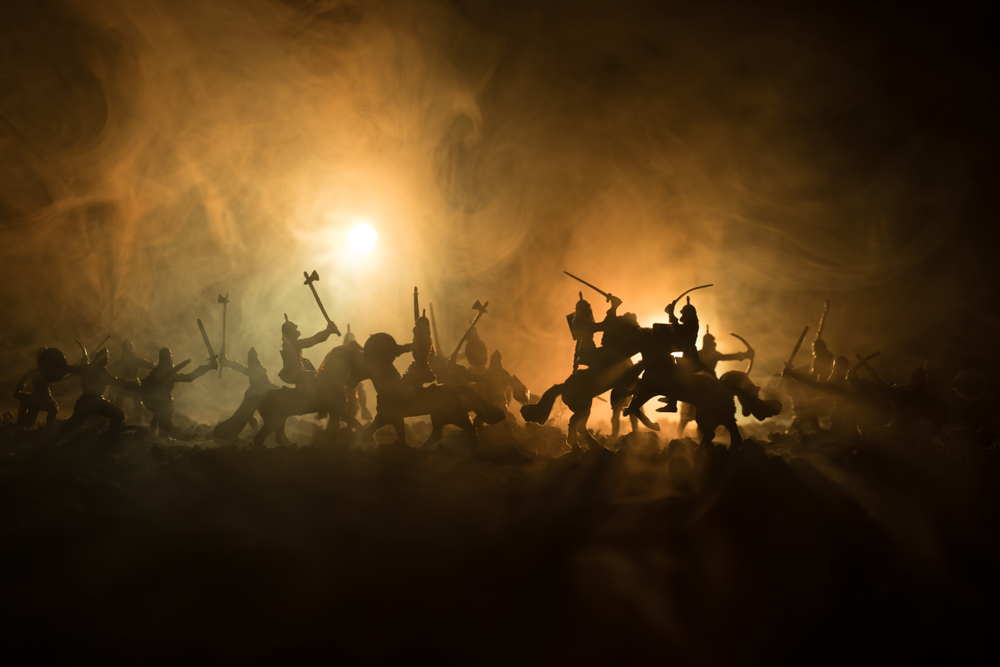
E5.4.9 The 7th Crusade (1248 – 1254 CE)
- [53]
- Another unsuccessful Crusade led by King Louis IX of France
E5.4.10 The 8th Crusade (1270 CE)
- [54]
- Another unsuccessful Crusade led by the French King Louis IX again. He died of an illness during this Crusade, which derailed it shortly after it started
- It was the last official Crusade and the only one after the Abbasid Caliphate
E5.4.11 The Fall of Acre in 1291 CE to the Mamluk Caliphate
- The Mamluk Sultanate ruled most of Palestine out of Egypt from 1250
- As indicated in E5.2.4 above, they only became the Mamluk Caliphate in 1261
- When they conquered Acre in 1291, that signified the official end of the Crusader states, and they then ruled the entire Palestine until 1517, when they were conquered by the Ottoman Empire.

E5.5 The Ottoman Empire Rules Palestine
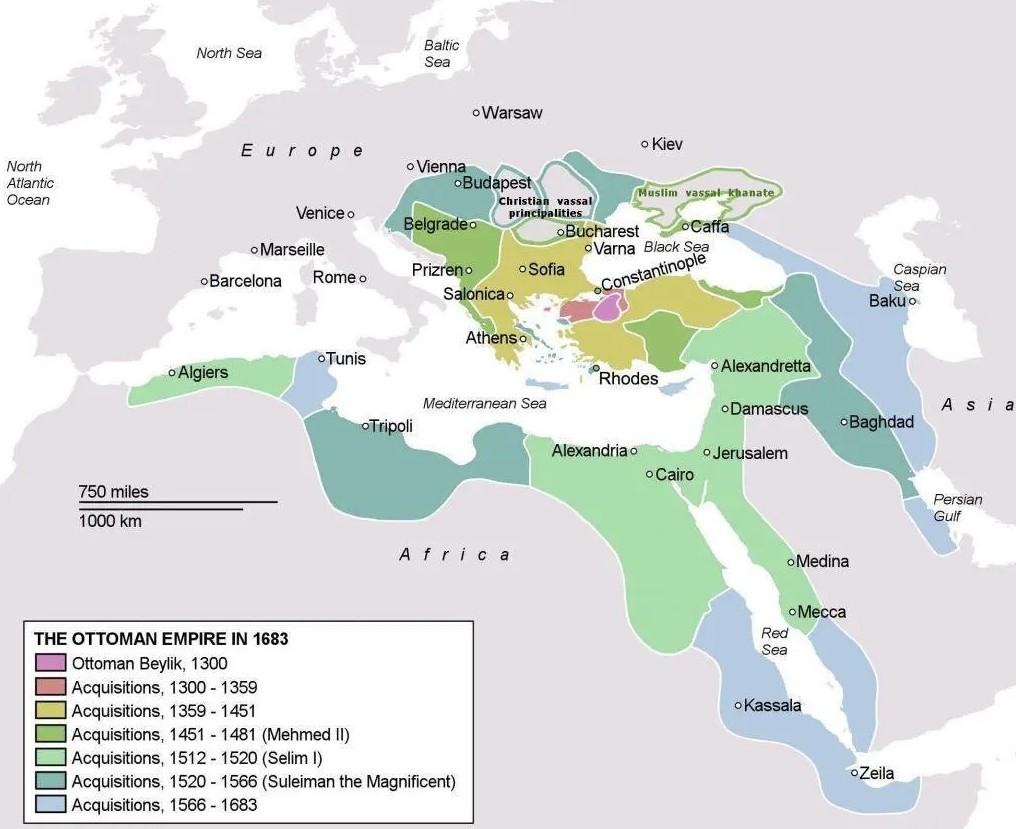
- As mentioned in E5.2.5 above, the Ottoman Empire was established in 1299. It continued to expand, while the Mamluk Dynasty was still the official Caliphate
- General sources: [26] [27] [37] [55] [56] [57] [58] [59]
- Sunni Islam was the predominant religion in the Ottoman Empire, but the northern parts of the Empire was mostly Christian (like the Balkans)
- In the 1st two centuries of the Ottoman Empire, it primarily expanded north and conquered most of the land of the Byzantine Empire
- By 1450 the Byzantine Empire consisted only of Constantinople itself
- On 29 May 1453 Sultan Mehmed II conquered Constantinople, after a 55-day siege, made it his capital and renamed it to Istanbul
- This marked the official end of the Byzantine Empire, and the last remnants of the Roman Empire
- The Ottoman Empire had quite a tolerant policy towards other religions and Jews and Christians had protections and freedoms as dhimmis, while they had to pay the jizyah tax
- For example, in 1492 when Jews were forcibly expelled from Christian Spain, many of them found refuge in the Ottoman Empire (see Episode 6 for more details)
- By the 16th century the Ottomans turned south too, against the Muslim Caliphate
- Under Selim I they conquered the Mamluks in 1517 (see the green acquisition on the map above) and with that they became the Ottoman Caliphate and the rulers of Palestine
- The Mamluks became a vassal of the Ottomans and received limited self-governance in Egypt. The Ottomans also used the mamluk soldiers from time to time
- Under Suleiman the Magnificent the Ottoman Empire reached its peak between 1520 and 1566
- Sultan Ahmet Camii had the Sultan Ahmed Mosque built in Istanbul between 1609 and 1617. It became colloquially known as the Blue Mosque and is a major landmark in Istanbul, well worth a visit
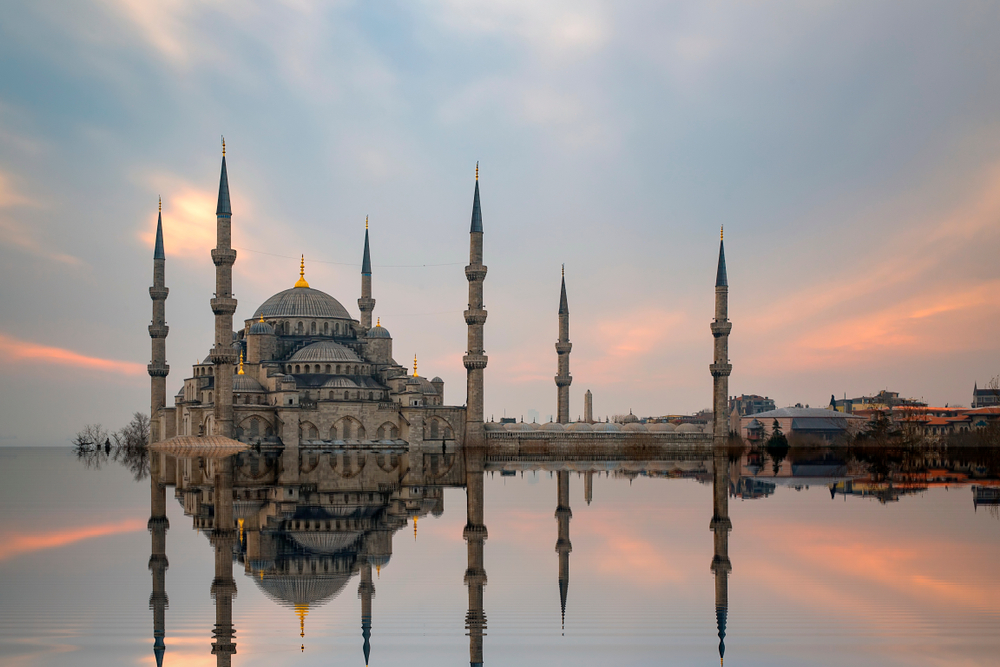
- Even though dhimmi status may have provided for better conditions for Jews in places like the Ottoman Empire than in parts of Christian Europe until the 19th century, it was nevertheless quite discriminatory and out of step with a civilizing world
- The influence of Enlightenment values gaining widespread acceptance across Europe did not only put pressure on Christianity to accept more tolerant values
- The Western powers started putting pressure on the Ottoman Empire as its political power started to dwindle
- And on 18 February 1856, the Ottoman Reform Edict of 1856 was published which abolished the “dhimmi” status and the “jizya” tax
- Ottoman statistics from 1878 indicated that the Jewish population of Palestine was 3% and that its lingua franca was Arabic
- There was peaceful co-existence between Muslims, Jews and Christians during the rule of the Ottoman Empire
- The Ottoman Empire largely retained the administrative regions used by the Mamluk Dynasty. Palestine was divided into 3 Sanjaks:
- The Independent Sanjak of Jerusalem (which included Gaza, and was not part of a Vilayet)
- Sanjak of Nablus (part of the Vilayet of Beirut)
- Sanjak of Acre/Akko (part of the Vilayet of Beirut)
- More information on the administrative system used by the Ottoman Empire can be found here [59b]
- The Ottoman Empire ruled Palestine for 400 years until December 1917, when British forces conquered Jerusalem during WWI
- The Empire surrendered on 30 Oct 1918 during WWI and officially came to an end in 1922 when it was replaced by the Turkish Republic (see Episode 8)
- For the entire time it ruled Palestine it was both the Ottoman Empire and the Caliphate
- The Caliphate was only officially abolished on 3 March 1924 by the Grand National Assembly of Turkey.


Left: Administrative Regions in Palestine under the Ottoman Empire [Image credit: PASSIA Maps, Palestinian Academic Society]
E5.6 Palestine Episode 5 – Critical Insights
E5.6.1 INSIGHT 1 – Layer 2 of the Zionist Narrative
- The Story
- The evidence is so overwhelming against a forced exile of Jews by the Romans in 70 CE that some Zionist historians switched to a new exile story. Examples are Yitzhuk Baer and Ben-Zion Dinur of the Hebrew University in Jerusalem
- This story involves the forced displacement of Jews by their Arab conquerors in 638 CE instead of by the Romans in 70 CE
- There were a few advantages for them in using a later exile date:
- It got them around the evidence against the 70 CE “exile”, including the large-scale Bar-Kokhba Revolt (see Episode 4)
- It places the Jews in Palestine for another 550 years, strengthening a historical claim to the land a little
- Dinur writes about “the ceaseless penetration of the desert people into the country” and the “capture of the agriculture by the new conquerors and their seizure of Jewish lands” [60]. According to this story:
- The Judeans did not convert to Islam
- The Arabs dispossessed and exiled the Jews
- Arab tribes then settled on the land in Palestine, replacing the Judeans.
- However, he does this without any evidence, while the 638 CE Exile story is even less substantiated than the 70 CE story (and while other historians call his lack of evidence cited as “embarrassing” for a historian)
- Let’s assess the evidence: “Did the Arabs really implement a policy of land colonialization? Where did the hundreds of thousands of dispossessed Judean peasants go? Did they obtain or capture land in other countries? Did they establish Hebrew agricultural settlements in some other place, near or far? Or did the ’tillers of the soil’ change their occupation in the seventh century and become transformed into a peripatetic people of merchants and moneychangers wandering about the alien lands of ‘exile’? The Zionist historiographic discourse offers no rational answers to these questions.” [61]
- Key evidence:
- [62]
- The Caliphate did not follow a policy of dispossession nor of exiling local populations (much like other conquering empires)
- The Arab army which conquered Palestine was a relatively small one, estimated at a maximum of 46,000 soldiers
- Most of them were moved on to battles in other parts of the Byzantine Empire (like Egypt), as the expansion continued at quite a fast pace
- Only a small number were left behind, some of whom brought their families
- This may have involved small-scale dispossession
- The Arabs were known for being very proud conquerors who did not mingle much with the local population under their control (i.e. they looked down on the local Judeans)
- The Arab tribes were by and large not farmers, with neither the inclination nor the skills to replace all the farmers of Palestine
- By the end of the 19th century (as pointed out by Belkind, see E5.6.2 below) [63]:
- Many Hebrew place names have been retained in Palestine, unlike the more recent Greek and Roman names
- The local Arabic dialect included a large number of Aramaic and Hebrew words
- Many cemeteries were combined Muslim and Jewish ones
- The local Palestinians did not refer to themselves as Arabs. They called themselves fellahin (farmers) or Muslims, while they called the Bedouin “Arabs”
- By the early 20th century, the well-researched publication by Ben-Gurion and Ben-Zvi added more supporting evidence (see E5.6.2 below) [64]:
- 210 Occupied villages still had Hebrew names
- Also “tens of thousands” place names remained Hebrew (like springs, streams, mountains, ruins, settlements, valleys and hills)
- There was a code of “fellahin law” known as Shariat al Khalil (the laws of the Patriarch Abraham), which was in use with Islamic law
- Many villages did not only have mosques, but also shrines of the 3 Israelite patriarchs, kings and prophets

“The fellahin are not descendants of the Arab conquerors, who captured Eretz Israel and Syria in the seventh century. The Arab victors did not destroy the agricultural population they found in the country. They expelled only the alien Byzantine rulers, and did not touch the local population. Nor did the Arabs go in for settlement. Even in their former habitations, the Arabians did not engage in farming” – David Ben-Gurion (first Israeli Prime Minister) in “Eretz Israel in the Past and in the Present”, 1918
E5.6.2 INSIGHT 2 – What happened to the Jews in Palestine after the Muslim Conquest in 638 CE?
- If the Judeans were not expelled as per the Layer 2 narrative, what happened to them?
- The Conclusion of Credible Zionist sources:
- Israel Belkind was one of the first Zionists to migrate to Palestine in 1882. “The land was abandoned by the upper strata, the scholars, the Torah men, to whom religion came before country. Perhaps, too, so did many of the mobile urban people. But the tillers of the soil remained attached to their land”. He was of the opinion that many of the Palestinians they encountered were their “own flesh and blood”, which he regarded as more important than religion [63]
- The most significant source on this is a book published in 1918 by David Ben-Gurion himself (the first Israeli Prime Minister) and Yitzhak Ben-Zvi (a future Israeli President): “The fellahin are not descendants of the Arab conquerors, who captured Eretz Israel and Syria in the seventh century. The Arab victors did not destroy the agricultural population they found in the country. They expelled only the alien Byzantine rulers, and did not touch the local population. Nor did the Arabs go in for settlement. Even in their former habitations, the Arabians did not engage in farming… They did not seek new lands on which to settle their peasantry, which hardly existed. Their whole interest in the new countries was political, religious and material: to rule, to propagate Isam and to collect taxes.” [64] [64b]
- Ben-Zvi followed that up with another book in 1929, in which he concluded “Obviously it would be mistaken to say that all the fellahin are descendants of the ancient Jews, but it can be said of most of them, or their core” [65]. In that same year the first serious riots broke out in Palestine, and as I’ll show in Episode 9, that led to Ben-Gurion and Ben-Zvi going completely silent on the Palestinians as descendants of the ancient Judeans
- Ben Borochov (an influential leader among the Zionist left wing, and a big critic of Herzl) wrote “The local population in Palestine is racially more closely related to the Jews than to any other people, even among the Semitic ones. It is quite probable that the fellahin in Palestine are direct descendants of the Jewish and Canaanite rural population, with a slight admixture of Arab blood” [66]
- Abraham Polak, an Israeli historian and Zionist, argued in 1967 that there was a considerable likelihood that Judeans converted to Islam, that the Palestinians of his time were direct descendants of these Judeans (with some other mixing with Greeks, Egyptians and Arabs, and that this topic should be seriously studied [67]. Polak’s writing and request for further study were ignored by the Zionist academics
- What really happened after 638 CE was not a replacement of people, but a cultural transformation: a long process of Arabization and Islamization
- Arabization [62]:
- By the 7th century there was already an existing Arab population
- After 638 CE there was a further inflow of Arabs
- There was a close relation between these two Semitic languages:
- Aramaic (spoken by Christian peasants and lower-class Jews) and
- Arabic (spoken by some locals since Roman rule, and the new arrivals from Arabia, after 638 CE)
- Arabization also served as an equalizer in a society previously stratified by language
- Despite this gradual Arabization, when the crusaders arrived in the “Holy Land” in the 11th century they found many Muslims there still speaking Aramaic, a further indication of conversion to Islam instead of a population replacement
- This gradual Arabization was accompanied by conversion to Islam (Islamization), from both the Aramaic speaking Christians and Jews [62]
- There were always conversions after conquests by a different empire, for a variety of reasons (like self-interest, submitting to the new powers and following the crowd). In this case there were more synergy and reasons for a conversion
- Just as the majority of Jews in Jerusalem converted to Christianity under Christian rule, large numbers of Christians and Jews converted to Islam under Muslim rule
- There is especially evidence of large-scale conversions from Jews in Samariah (the Old Northern Kingdom of Israel) to Islam, but also from Judea (the southern Kingdom) [68]
- Some of the main reasons Jews converted to Islam in Palestine:
- The Muslims were not as oppressive as the Byzantines. They typically allowed freedom of religion (as long as you had a monotheistic faith, “The People of the Book”) with no forced conversions like the Byzantines (or their own Hasmonean Kingdom), so Jews were more positive about them and their rule
- They taxed non-Muslims with the jizyah tax, which was a significant factor
- Their languages were closely related (Aramaic vs Arabic)
- The Muslims also accepted most of the Tanakh (the Hebrew Bible)
- They liked the monotheism of Islam with Mohammed selling himself just as a prophet (and not a god), especially compared with the Christians who declared Jesus a god in 380 CE (almost 4 centuries after his death and less than 2 centuries earlier)
- Although they did not lose their land, they had concerns about potentially losing it under their new rulers
- Although they had dhimmi status with some level of protection, it was by no means the same status as a Muslim
- All-in-all there were several advantages to convert, which was not that attractive under the Byzantines.
- Evading the jizyah tax was possibly the major factor, and indications are that there were such large-scale conversions that the Caliphate had to re-assess their tax policy due to the drain on tax revenue [69]
- Three important clarifications to avoid any misunderstandings:
- These were not forced conversions, but it still was the result of the military conquest of Palestine, and the subsequent incentives to convert
- All Jews did not convert to Islam. A Jewish community practicing Judaism remained in Palestine
- The fact that there was not a large-scale forced expulsion of Jews does not mean that no Jews left Palestine. Although they experienced better conditions than under the Byzantines, the choice between dhimmi status and conversion to Islam was still not acceptable to some Jews resulting in their migration
- The bottom line of this insight is highly significant: it is likely that the majority of modern-day Palestinians are descendants of the ancient Israelites.
“Obviously it would be mistaken to say that all the fellahin are descendants of the ancient Jews, but it can be said of most of them, or their core” – Yitzhak Ben-Zvi (future Israeli President) in “Our Population in the Country”, 1929
E5.6.3 INSIGHT 3 – Violence within Islam
- I’ll let the historical facts speak for themselves, and focus on the early history of Islam
- Mohammed in Medina (622 – 630)
- When the tribes of Mecca (including his own tribe, the Quraysh) rejected Mohammed’s message and his status as prophet, he fled to Medina in 622
- There he built an army in a determined and systematic way
- He launched around 80-100 military expeditions, and used insurgency to gradually build his military force, their weapons and increase his followers
- When the Jewish tribe, Banu Qurayza, rejected his message and refused to cooperate with him, he laid siege to their fortress and after their surrender massacred all the men in cold blood in Medina and sold the women and children into slavery
- He established himself as a prophet through a highly successful military campaign in which he proved himself an exceptional leader and military strategist
- The historical record is pretty clear: if he only preached his message without building an army and conquering those who rejected his message (in other words if he was only a prophet and not a warrior-prophet), there would be no Islam today
- Return to Mecca (630)
- After 8 years, when he built a strong enough military force, he returned to Mecca to conquer them militarily and to enforce his status as prophet
- He executed the Meccan leaders who opposed him and provided pardons to the rest (provided that they submit to him)
- The first 60 years after Mohammed’s death
- The 1st Caliph (Abu Bakr) immediately had to fight the Ridda Wars (September 632 to June 633) to stamp out a rebellion by some of the Arab tribes, which also involved claims of rival prophets. He unified the Arab tribes by force
- Three of these first 4 Rashidun Caliphs (all close companions of Mohammed) were assassinated by other Muslims. There was also an assassination attempt on the 5th Caliph (Hasan, Ali’s son and successor)
- There were 2 Fitnas (Civil Wars) for control of the Caliphate within the 1st 60 years of its existence
- The 1st Fitna overthrew the first Rashidun Caliphate in 661 with military force
- There was a parallel Caliphate for 8 years during the 2nd Fitna (see E5.2.2 for more detail). This was not settled by theological debate or diplomatic efforts, but by war in which the other Caliph (al-Zubayr) was killed in 692
- The Golden Age of the Abbasid Caliphate
- During the 500 years of the Abbasid Caliphate (750 – 1258 CE, which is regarded as the Muslim Golden Age), Palestine was ruled by 5 different Muslim sultanates
- They all waged war on one another (the Abbasids, the Seljuks, the Fatimids, the Ayyubids and the Khwarazmians) and on the Crusaders
- It was a very violent Golden Age
- Changes from one Caliphate to the next was always through war, without a single exception during the entire history of the Muslim Caliphate (632 – 1924)
- The First Fitna (Civil War) violently ended the Rashidun Caliphate in 661 and established the new Umayyad Caliphate
- The 2nd Fitna crushed the parallel Caliphate in Mecca in 692 and consolidated the Umayyad Caliphate
- The Abbasid Sultanate conquered the Umayyads around 750 to become the Abbasid Caliphate
- The Mamluk Sultanate conquered the Abbasids to become the Mamluk Caliphate in 1261 (after 3 years without a Caliph)
- The Ottoman Empire conquered the Mamluks in 1517 to become the Ottoman Caliphate. The Ottoman Empire fell with WWI and the Ottoman Caliphate was officially abolished by the Turkish parliament in 1924
- So, when some Muslim apologists today paint Mohammed in the most glowing terms as peaceful, patient and patiently letting his divine message attract followers, like these articles ([70] [71]), it is simply a religious narrative completely at odds with the historical record and with arguments defying basic logic
- All this violence and warfare listed above were between Muslims, and it started in 622 in Medina with Mohammed
- It cannot be blamed on the corruption of his peaceful message, on other religions, the West, colonialism or the state of Israel, in any way
- These other forces and factors certainly had an aggravating impact on violence and war later on but cannot be blamed for Islam’s violent birth or the violence within the early Muslim Caliphate.
E5.6.4 INSIGHT 4 – The Third Monotheistic Abrahamic Faith Gains Political Power
- We’ve seen since the Bronze Age how empires and kingdoms waged war in the name of a variety of gods: the Assyrians, the Persians, the Egyptians, the Canaanites, the Israelites, the Romans and the Christian Roman Empire. Muslims fighting for Allah was not unique at all
- We’ve also seen in previous episodes how ruthlessly the 1st two Abrahamic faiths (Judaism and Christianity) wielded political power. Islam was no exception in this regard either. One of many critical sources [69b]
- However, there are a few differences:
- Islam did not only start using violence once they acquired political power. Mohammed used violence, military campaigns and specifically insurgency to establish the religion
- The other two faiths did not build a religion around warfare or gave warfare such a central place in the service of their gods. “One of Muhammad’s most important innovations was convincing his troops that they were doing God’s work on earth. There were of course soldiers of other faiths who fought on religious grounds. But no army before Muhammad’s ever placed religion at the center of military motivation and defined the soldier primarily as an instrument of God’s will on earth… To die fighting in defense of the faith was to fulfill God’s will and become a martyr. Life itself was subordinate to the needs of the faith. Muslim soldiers killed in battle were accorded the highest respect on the Arab scale of values.” [16]
- And the bottom line is that all 3 Abrahamic faiths used violence (against each other, against their own followers or against people not accepting their message), with the following in common
- Divine sanction
- A mentality of “god on our side”
- Intolerance
- This episode is not taking on the big task of evaluating the extent to which violence is inherent in these religions, it simply makes historical observations, which show that using imaginary deities to mobilize people for a cause and to use violence in service of that cause proved very effective throughout history.
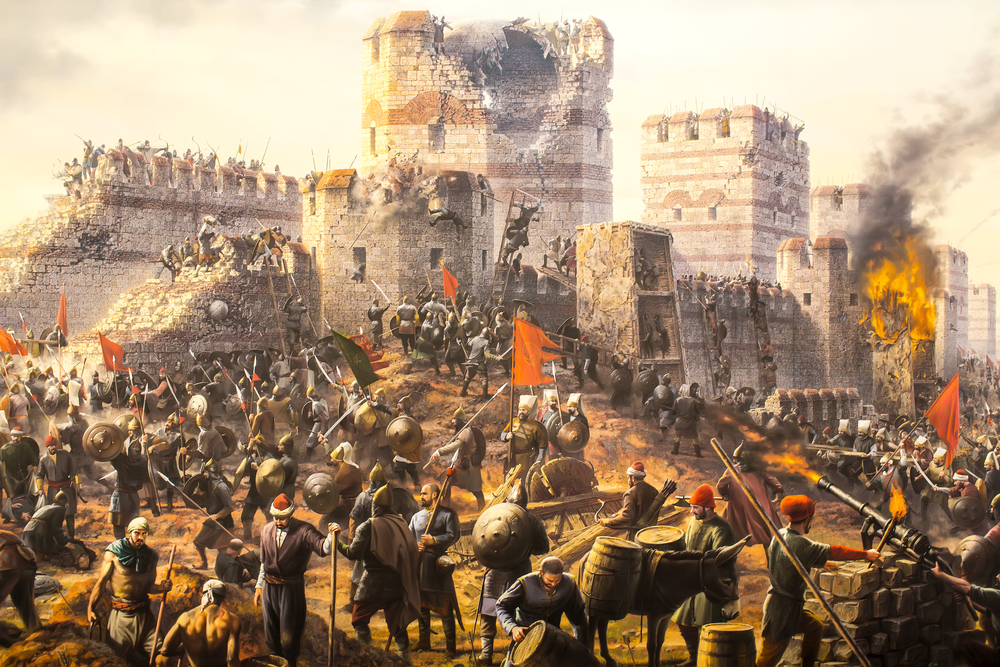
‘Using imaginary deities to mobilize people for a cause, and to use violence in service of that cause, proved very effective throughout history‘
E5.6.5 INSIGHT5 – Jews were initially more closely aligned with Islam than with Christianity
- Despite the myth of the “Judeo-Christian Tradition” which developed in the 19th century, until then the Jews were more closely aligned with Islam than with Christianity. Episode 7 will cover this in more detail (as did this CSF article: https://thecsf.xyz/the-csf-morality-series-part-4-the-supposed-judeo-christian-foundation-of-western-civilization/)
- Some examples:
- Christian anti-Semitism started to develop in the 4th century and increased until the 19th century, with strong discrimination against Jews in Christian Europe, including oppression
- When the Muslims conquered Palestine in 638, the Jews preferred their rule to the oppression of the Christian Byzantine Empire. The Jews were treated better under Muslim Caliphates, especially the Ottoman Empire, than under Christian rule in Palestine and Europe
- There was more theological alignment between the Jews and the Muslims:
- The Muslims also accepted the Tanakh, key stories of Judaism and their prophets. Although the same applied to Christianity, there were other theological factors offsetting this
- Both were strongly monotheistic
- With the Christians creating the dogma of the Trinity in 381 CE at the First Council of Constantinople, it increased the rift between them and the Jews. The latter found this development unacceptable and offensive, and had more affinity with Mohammed who was only painted as a prophet and not a god
- The Crusades involved massacres of Jews in Europe and Jerusalem by the Christian crusaders
- In Episode 6 we’ll look at the way Jews were treated by the Christian rulers of Spain, and their response during the Muslim invasion. For now, they assisted the Muslim invaders, sided with them and received prominent administrative positions
- This only started to change in the 19th century with the rise of Zionism and the myth of the “Judeo-Christian Tradition”
E5.6.6 INSIGHT 6 – Muslim Rule in Palestine for the last 1300 years (until 1917)
- Despite all the invasions and upheaval Palestine was more or less continuously under Muslim rule for 1300 years from 638, with the exception of 2 short stints during the Crusades when it was under Christian rule of the Western forces for a total of 103 years
- 1099 – 1187 (88 years)
- 1229 – 1244 (15 years)
- This 103 years of Crusader rule was by no means part of the mythological Judeo-Christian tradition. It was more anti-Jewish than pro-Jewish, with Jews massacred by Crusaders in Europe, in Jerusalem and in other Crusader States.
- Palestine was uninterruptedly ruled by Muslim forces for 673 years (1244 – 1917). These forces were ethnically mostly Arab, Turkish, Kurdish and Persian
- During all this time it was never ruled by Jews. There was no Jewish rule of the area since the last Hasmonean king in 63 BCE (2,088 years ago), when the short-lived rule of these kings was ended by the Romans
- According to the evidence and the early Zionist leaders, the majority of the Muslims subjects in Palestine were Jews who converted to Islam
- And in terms of the big picture, the ancient Israelite Kingdoms lasted for about 600 years of the 5,000-year history since the Early Bronze Age. The Jews were by no means the first, the most significant, the longest or the most recent rulers or even inhabitants of the area. What makes their claim to the land valid/undisputable?

